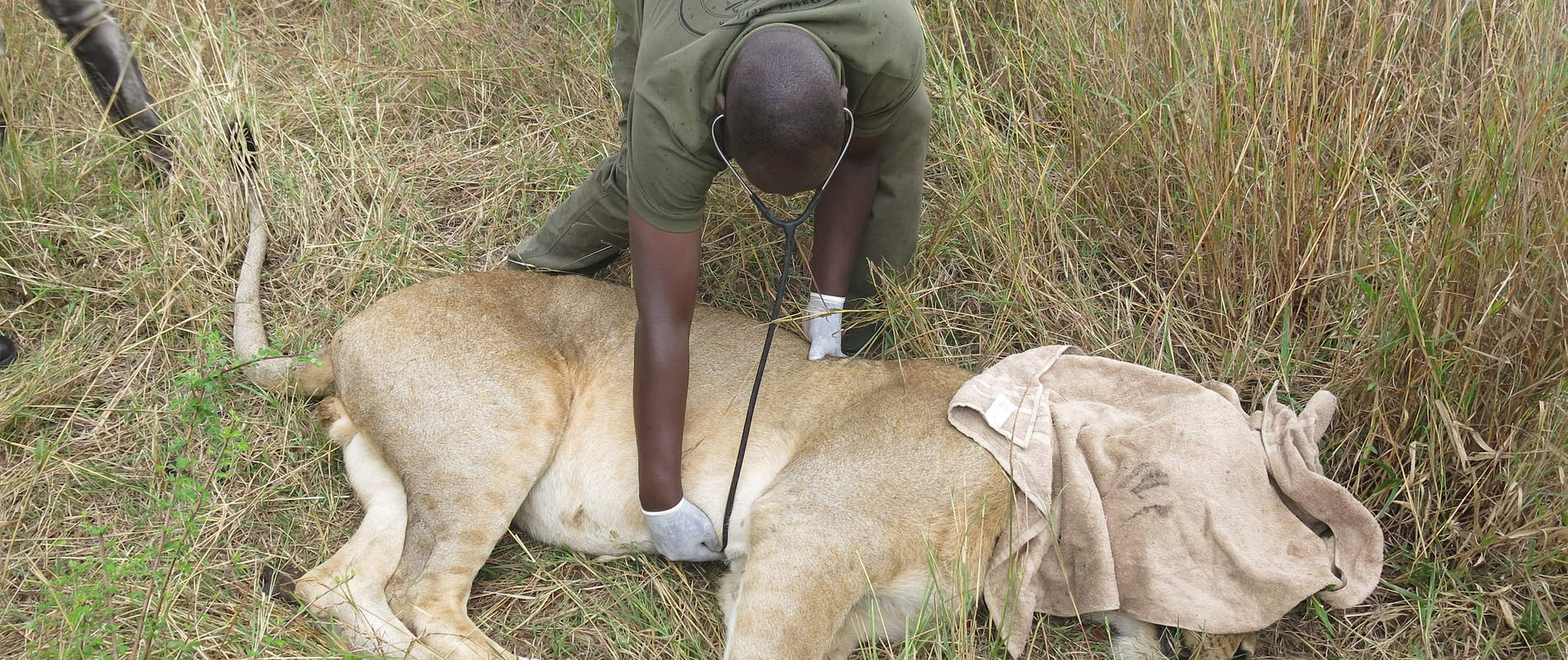Introduction The period under review was characterised by low precipitation at the beginning with significant improvement towards the end
Introduction
The period under review was characterised by low precipitation at the beginning with significant improvement towards the end. Many migratory wildebeests are still seen acting as a big attraction to tourists. Herbivores still have a lot in terms of fodder and browsing material and with the precipitation, there is sufficient water for their use.
The following are cases that were handled during the period:
1. INJURED ELEPHANT
Date: 13th August 2017
Species: African elephant
Age: Young adult
Sex: Male
Location: Olarro Conservancy (Siana)
History
This elephant was seen with right hind leg problems by the Elephant aware and Olarro conservancy patrol team and called us for assessment and help.
General observation.
This young bull was located near a small thicket with other elephants browsing with a swelling on the lateral side of his right hind leg. He walked with difficulty although his body condition was still good. A small discharging wound was seen slightly dorsal to the swelling.
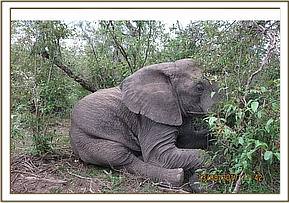

Immobilization, examination and treatment.
Restraint was achieved chemically by use of 13mgsetorphine hydrochloride delivered through a 1.5 dainjectdart.Darting was done from a vehicle. It took eight minutes for the drugs to take full effect with the elephant assuming sternal recumbency having moved to a small thicket. Though the posture was not the best, it presented a good position for wound examination and handling and this was done quickly before the elephant being flipped over to his lateral position for the remainder of the treatments.This was a spear wound which had turned septic with pus forming a pouch ventrally. An opening was created at the most ventral position of the swelling for effective pus drainage.
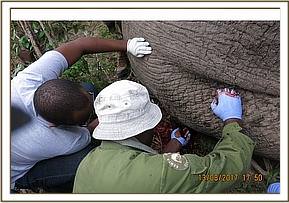

Through and through lavage technique was applied when cleaning the wound with copious amount of water being introduced dorsally and drained ventrally. Hydrogen peroxide was used to remove all the debris before tincture of iodine being used to disinfect. Green clay was then packed to absorb toxins and hasten healing process.Other treatments include parenteral administration of 30000mgs amoxicillin antibiotic and 5000mgs flunixin meglumine anti-inflammatory.
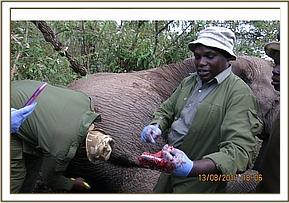

Reversal
Done by use of 36mgs diprenorphine hydrochloride through a prominent ear vein.
Prognosis
Good.
2. THE NOTCH PRIDE OF LIONS
History
Earlier in the month, there were reports that Notch 2 and his brother Caesar were injured at Lookout rea of Masai Mara National Reserve. Notch 2 was said to have a scratch close to his right eye and Caesar was seen limping with fresh injuries on his hindlegs.All these were thought to have been occasioned by territorial conflicts with other males. Caesar was reported seen late on the evening of 8th August 2017 while Notch2 was seen on 7thAugust 2017.
An arrangement to have them be treated the next morning was made as they were seen very late in the evening. However, none of the two lions was spotted for treatment the next day with a search being mounted by all concerned including the County Government Rangers.
Continuous search was conducted for the next one week in vain. Notch 2 re-appeared later with the scratch on his eye having completely healed while Caser has not been traced so far.
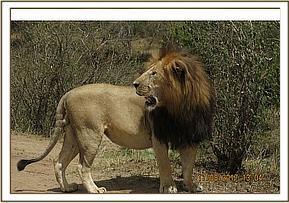

3. SPEARED ELEPHANT
Date: 15th August 2017
Species: African elephant
Age: Calf (about 3.5 years)
Sex: Female
Location: Sand River
History
This lone calf was seen by Sand River bank with a spear head sticking on her back by a tour guide. He called the veterinary unit for intervention.
General observation
This calf was by herself browsing on lush forage at the river bank. A spear head was seen stick on the right side slightly off her sacrum.
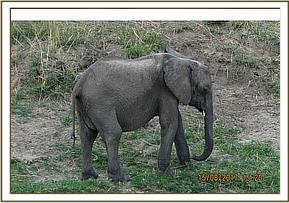

Immobilization, examination and treatment.
Immobilization was achieved by use of 3mgsetorphine delivered in a 1.5mldaninject dart with darting being done from a vehicle. He took ten minutes before being fully narcotized assuming left lateral recumbency. Examination revealed a spearhead firmly lodged in her right sacral area missing the spine by inches. The spearhead was retrieved gently to reduce further damages. Her posterior functions including defaecation and micturition were not affected an indication the spine was intact. Her gait was good and she moved with stability.
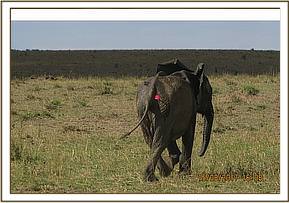

The resultant wound was disinfected with tincture of iodine and cloxacillin ointment infused. Green clay was then packed to absorb toxins and hasten healing. Other treatments instituted include parenteral administration of 7500mgs amoxicillin antibiotic and 1500mgs flunixin meglumine anti-inflammatory. He also got a dose of multivitamin injection and cotasal which helps in muscle and nerve regeneration.


Reversal
Achieved by intravenous administration of 12mgs diprenorphine hydrochloride through an ear vein.
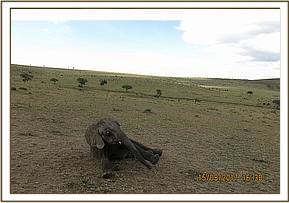

She woke up in four minutes and moved to a small thicket. The county security team was tasked to monitor this elephant and report the progress. So far she seems to be doing well.
4. INJURED LION
Date: 16th August 2017
Species: African lion
Age: About3 years
Sex: Male
Location: Sand River area
History
This young lion was seen by tourists lying under a shade in pain. He had three firmly attached porcupine quills on his left shoulder. He got this after trying to kill a porcupine. They called the mobile veterinary team for intervention.
General observation
This lion was found lying in one position near a small pool and under a shade. He appeared to be in great pain with the quills intact.


Immobilization, examination and treatment
Restraint was chemically achieved by use of a combination of 4.8mgs medetomidine and 200mgs ketamine hydrochloride delivered through a 3mldaninjectdart.Darting was carried out from a vehicle with the drugs taking full effect after ten minutes.
Examination revealed recently attached porcupine quills on the left side of his shoulder. They were pulled out and the wounds disinfected with tincture of iodine.Cloxacillin antibiotic ointment was also infused. Additional treatments include parenteral administration of 3000mgs amoxicillin antibiotic and 20mgs Dexamethasone sodium anti-inflammatory.
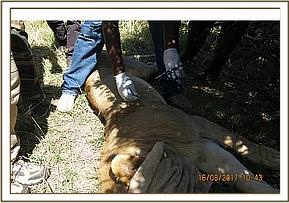

Reversal
Achieved by use of 15mgsatepamezole hydrochloride given intramuscularly one hour after immobilization. He woke up in ten minutes and sat within the shade.
Prognosis
Good.
5. LION COLLARING
Date: 16th August 2017
Species: African lion
Sex: Male
Age: Sub adult
Location: Mara Triangle
History
In order to understand dynamics of lion population in Mara Ecosystem, KWS together with Mara Lion project, Mara National Reserve, Mara Triangle Conservancy with surrounding conservancies have partnered to collar a few sub adult male lions. This research oriented activity helps to explain where these male lions go to after they leave their prides. It also tries to explain the percentage that make to maturity and take over pride dominancy. Few males end up being dominant and the rest disappear, no one knows what happens to them.

Capture and collar deployment
This sub adult male in good body condition was found in Mara Triangle having moved from Mara North with his brother.Immobilization was achieved by use of a combination of 4.8mgs medetomidine and 200mgs ketamine hydrochloride. This was delivered via daninject dart and darting from a vehicle. It took ten minutes for the drugs to take full effect and after confirming that he was stable, an appropriate satellite/GSM collar was deployed. Morphometric measurements and biological samples were also taken for research purposes.
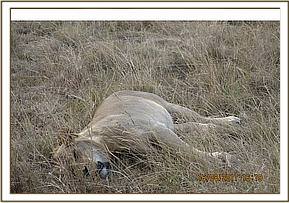
Reversal
Done one hour after immobilization by intramuscular administration of 15mgsatepamezolehydrochloride.He woke up in ten minutes and relaxed under a shade.
6. ZEBRA WITH A SNARE
Date: 16th August 2017
Species: Common zebra
Sex: Male
Age: Adult
Location: Mara Triangle
History
This zebra was seen by the veterinary team together with the Mara triangle rangers soon after collaring the lion. He had a snare round his neck.
Immobilization and snare removal
Restraint was achieved by use of a combination of 5mgsetorphine hydrochloride and 50mgs azaperone delivered through a 1.5mgsdaninject dart.Darting was done from a vehicle. It took five minutes for the drugs to take full effect. The snare was reasonably tight with no severe injuries inflicted though.
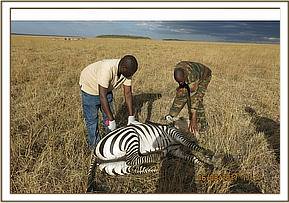

This was a braided cable wire which was cut loose and removed. Abrasion wounds were topically treated with oxytetracycline wound spray.
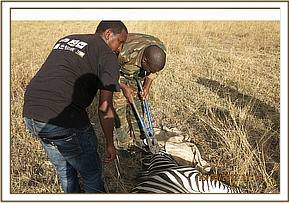

Reversal
Done by use of 18mgs diprenorphine hydrochloride given intravenously through the jugular vein. She woke up within two minutes of reversal to join other zebras.
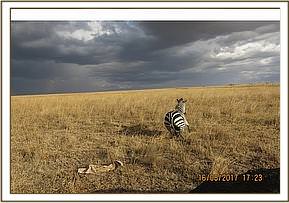

Prognosis
Good.
7. SPEARED BUFFALO
Date: 20th August 2017
Species: Cape buffalo
Sex: Male
Age: Adult
Location: Masai Mara National Reserve (Hammerkop area)
History
This mature bull, forming a small bachelor herd at Hammerkop area within Mara Reserve was seen with a spear sticking from his left abdomen by a tour guide. He called the veterinary unit and county security team for intervention.
General observation
This bull was found in distress and secluded away from the other bufalloes.A spear could be seen sticking from his left abdomen.
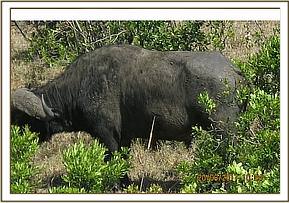
Immobilization, examination and treatment
Immobilization was achieved chemically by use of a combination of 7mgsetorphine hydrochloride and 60mgs azaperone delivered through a 1.5mldaninject dart. Darting was done from a vehicle. It took eight minutes for the drugs to take full effect with the bull assuming sternal recumbency. After applying blindfold, the spear was retrieved carefully to avoid creating more tissue damage.
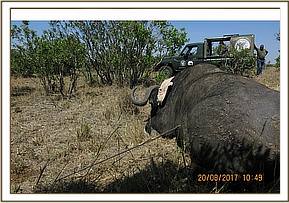
A third of the spear had been lodged at the rumen with some Ingesta seeping from the wound. The wound was cleaned and all Ingesta around the opening wiped out. Given this was a severely contaminated area, no suturing was preferred but left to heal by secondary intention just like most trocalized ruminants. Tincture of iodine and oxytetracycline spray was then applied to the wound. Other treatments administered include 6000mgs amoxicillin antibiotic and 1000mgs flunixin meglumine anti-inflammatory all given intramuscularly.
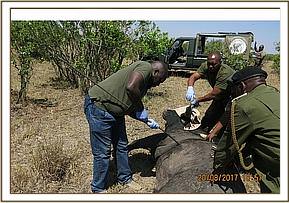

Reversal
Achieved by intravenous administration of 18mgs diprenorphine through jugular vein. He woke up in three minutes and moved into a small thicket.
Prognosis
Fair.He was spotted two days later much relieved and grazing.
8. SICK LIONESS
Date: 22nd August 2017
Species: African lion
Sex: Female
Age: Adult
Location: Naboisho Conservancy
History
This lioness with three young cubs which was with her niece who also has two cubs was reported sick on this date by the Conservancy rangers and Mara Lion Project teams. She had a swollen head and they requested the mobile veterinary services for intervention.
General observation
This lioness was seen aside from her cubs who were staying with her niece. She had a severely swollen face and kept lying down in a small thicket most of the time. She appeared dyspnoeic and her breathing sounds were audible from a distance as she struggled to breathe. This suggested that her airways were compressed by the swelling. The swelling was bilateral and its cause could not easily be determined. This was an acute problem. Among the differentials considered were snake bite to the head with cytotoxic venom, acute allergic reaction or wasp sting.
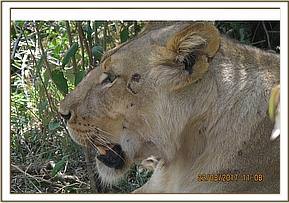
After considering all options and out of precaution, immobilization was ruled out as this would further complicate breathing and could easily lead to death. The team decided to administer anti-inflammatories remotely through darting by use of 3mldaninject darts.Two darts containing 6mgs dexamethasone sodium anti-inflammatories were prepared and delivered in turns from a vehicle. The needles were plain and the darts dropped off as soon as the drugs were delivered.
Mara Lion Project team and the Conservancy security personnel were tasked to monitor and report the progress of the lioness. She improved over the next 24 hours and was reported to have re-united with her cubs. The swelling had drastically subsided and she was seen feeding on a zebra kill with her cubs together with her niece.
Prognosis
Good.
9. INJURED ELEPHANT
Date: 23rd August 2017
Species: African elephant
Sex: Female
Age: Adult
Location: Musiara area (Masai Mara National Reserve)
History
This elephant, collared and christened Courtney was seen limping on her left forelimb by Governor’s camp management team. They called the mobile veterinary team for intervention.
General observation
Using emitted signals from the collar, the elephant was tracked to a thicket by Mara River at Musiara. She had a three-year-old calf. A small swelling was seen on her left shoulder without any open wound or discharge.
Immobilization, examination and treatment.
Immobilization was achieved by use of 15mgsetorphine hydrochloride delivered through a 1.5mldaninjectdart.Darting was done from a vehicle. This elephant did not move far but gave in to narcotic effects at the same spot after eight minutes. She assumed right lateral recumbency.

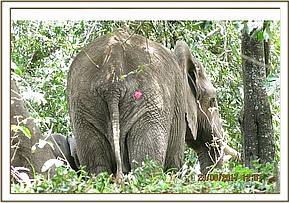


The calf was pushed aside by the team and kept at a distance as his mother was being attended to.An old wound was seen on the left side of her withers which was healing but no foreign body detected. Examination of the swelling on the left shoulder showed that it was a wound which had since closed. Scanning with a metal detector showed there could have been a metallic foreign object buried inside. The swelling was opened and probed and after a lot of search, an arrowhead was retrieved and this was thought to be the cause of her limping. All the wounds were debrided with hydrogen peroxide and disinfected with tincture of iodine. Green clay was then packed. Other treatments include parenteral administration of 30000mgs amoxicillin antibiotic and 5000mgs flunixin meglumine anti-inflammatory.
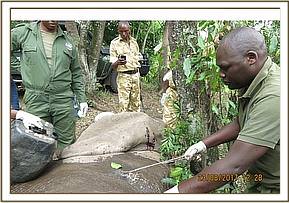

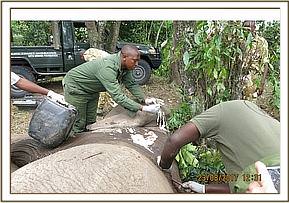

Reversal
Achieved by intravenous administration of 42mgs diprenorphine hydrochloride delivered through a prominent ear vein.She woke up three minutes after reversal and she was successfully herded to join her calf.
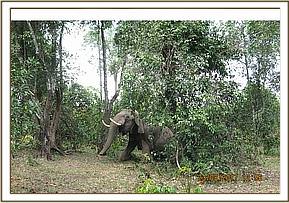

Prognosis
Good.
10. Dead Elephant cow
Date: 24th August 2017
Species: African elephant
Sex: Female
Age: Adult (over 50yrs old)
Location: BilaShaka area of Mara National Reserve
History
This elephant was seen dead on an open plain the morning of this date by the county government security patrol team. Her tusks were intact with no injuries seen.

General examination:
- He was found lying on her right side
- No injury was evident but his body condition had deteriorated.
- No active injury seen externally but old healed scars on her left flank and spine seen.
- Hyperkeratosis of her skin was notable.
- Nothing abnormal for her age seen externally.
On opening the carcass, the following findings were noted;
- There was extensive muscle cachexia associated with age.
- Several chondromas seen at the costochondral junctions.
- Both upper and lower molars were completely worn out.
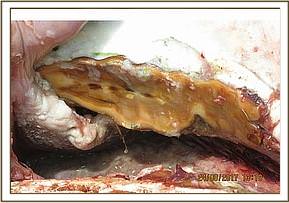
Conclusion
Considering the age of this elephant, all these findings point to expected geriatric associated complications and this elephant died of old age. The tusks were retrieved and taken by the county security team for custody and accounting.
11. INJURED LION
Date: 24th August 2017
Species: African lion
Sex: Male
Age: 3 years
Location: Mara Triangle Conservancy
History
This young male was seen by Mara triangle rangers alone and limping on his left hind leg. They requested the services of the veterinary unit for intervention.
General observation.
He was found near a Lugga and was very aggressive on approach. His left hind leg appeared wasted to some degree though he could still use it.
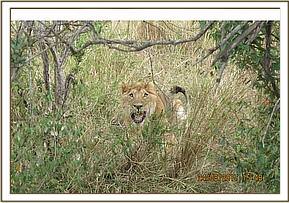

Immobilization, examination and treatment.
Restraint was achieved chemically by use of a combination of 4.8mgs medetomidine and 200mgs ketamine delivered remotely through a 3mldaninject dart.Darting was carried out from a vehicle. It took seven minutes for the drugs to take full effect with the lion assuming sternal recumbency. After confirming that he was stable, examination was conducted. He had a fresh bite wound on her back, sacral region of the spine. His left hind leg had no fresh injury but had poor musculature attributed to dystrophy of disuse. No fracture was detected.
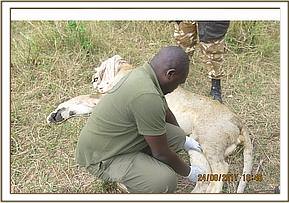
Closer examination revealed that this was a lion treated couple of months back at Talek area for a serious spear wound on his left hindleg.The injury had damaged the knee joint with the joint capsuled being torn and synovial fluid partly escaping. His condition then was bad as he could not use the leg completely. The joint was closed with sutures and the wound margins apposed. He healed completely but with a limp. The fresh wound was cleaned, disinfected with tincture of iodine and oxytetracycline spray applied.More treatments involved parenteral administration of 3000mgs amoxicillin antibiotic, 16mgs dexamethasone sodium anti-inflammatory and cotasal which helps in muscle and nerve regeneration.
Reversal
Done one hour after immobilization with slow intravenous administration of 19mgs of yohimbine through saphenous vein. He rose up and was stable within four minutes.
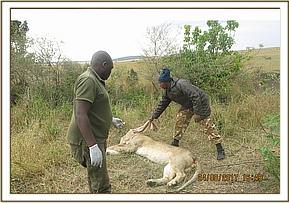
Prognosis
Good
12. INJURED LION
Date: 24th August 2017
Species: African lion
Sex: Male
Age: Adult
Location: Look out area of Mara Reserve
History
This old male was seen limping on his left forelimb by the county security patrol team. They called the veterinary team for intervention.
General observation
He was found lying a short distance from his brother who was with another female. He had a fresh cut on his front left limb.
Immobilization, examination and treatment
Restraint was achieved chemically by use of a combination of 200mgs ketamine and 6mgs medetomidine delivered in a 3mldaninject dart.Darting was done from a vehicle. It took four minutes for the drugs to take full effect and was examined after eight minutes.


He had a fresh sharp-edged wound on his left foreleg which appeared inflicted by a spear. A small wound was also seen externally below his jaw. The bigger and deeper wound on his leg was stitched after being cleaned and disinfected. Cloxacillin ointment was then infused. The small wound below the jaw was disinfected with tincture of iodine and infused with cloxacillin ointment.
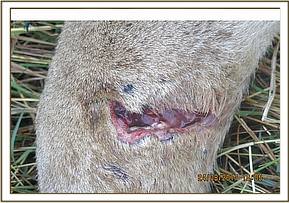

He also received 3000mgs amoxicillin antibiotic parenterally.
Reversal
Done one hour after immobilization by use of 19mgs yohimbine given intravenously through the saphenous vein. He woke up to join his brother in four minutes.


Prognosis
Good.
13. INJURED LIONESS
Date: 29th August 2017
Species: African lion
Sex: Female
Age: Adult
Location: Balloon crossing (Talek)
History
This lion was seen limping while walking by the Masai Mara National Reserve rangers. She with her other three sisters were nursing twelve young cubs. They called the mobile veterinary unit for assessment.
General observation
This mother was found with her sisters and cubs having fed on a wildebeest kill. She appeared to favour her right front limb while walking. Her body condition was good though.


Immobilization, examination and treatment
Restraint was achieved chemically by use of a combination of 4mgs medetomidine hydrochloride and 200mgs ketamine delivered in a 3mldaninject dart. Darting was done from a vehicle. It took seven minutes for the drugs to take full effect and a blindfold was put in place before examination.
Examination revealed no visible injury, but likely sprain to the right shoulder sustained while hunting. She was given 10mgs dexamethasone sodium anti-inflammatory and 3000mgs amoxicillin anti-biotic all intramuscularly.
Reversal
Done by administration of 19mgs yohimbine slow intravenously through the jugular vein. She rose up in four minutes to join the rest of the pride.
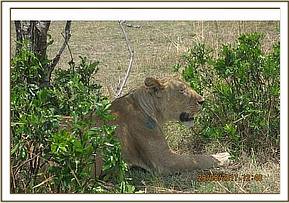
Prognosis.
Good.
